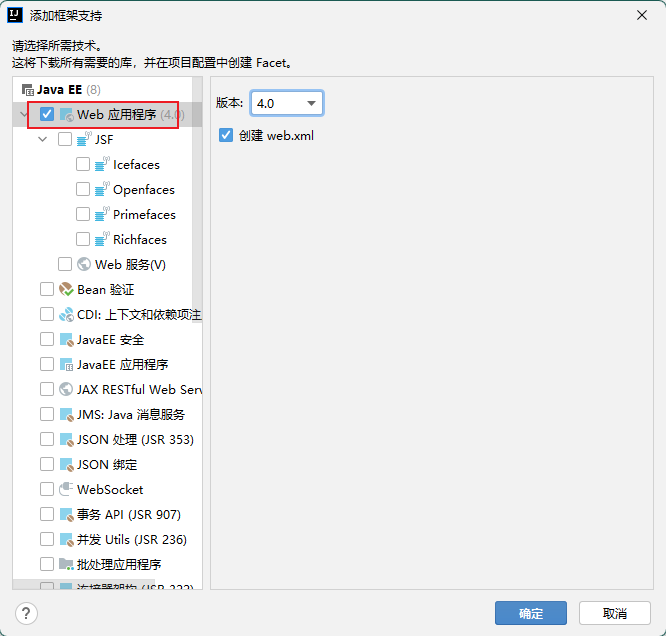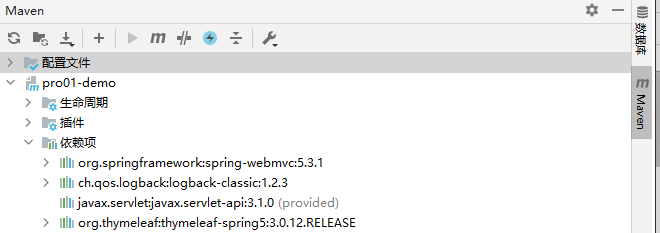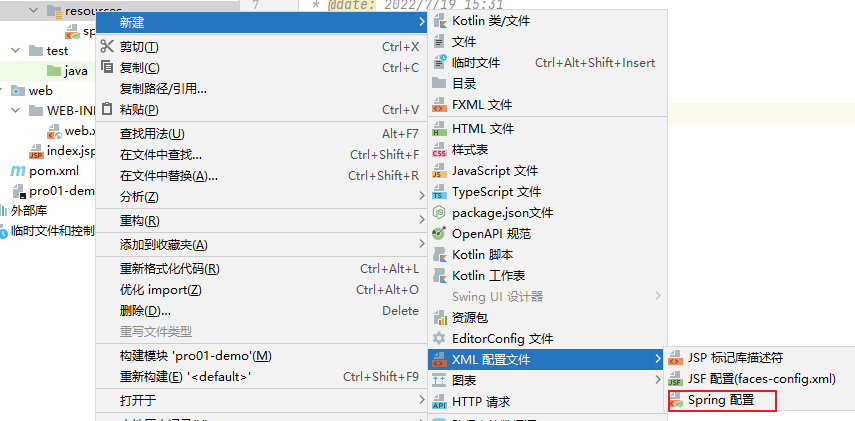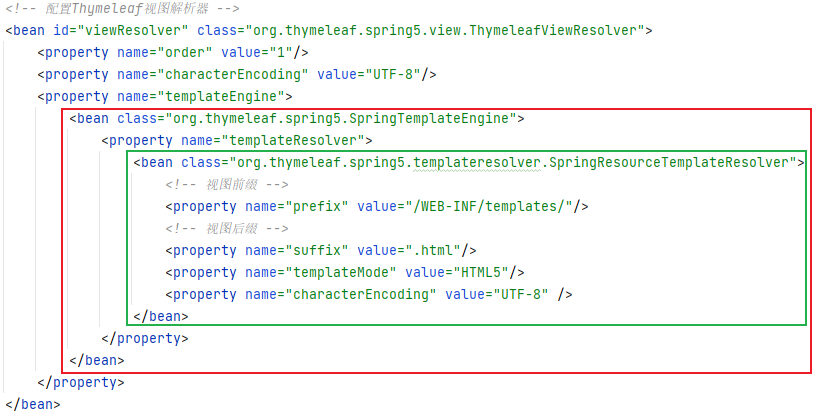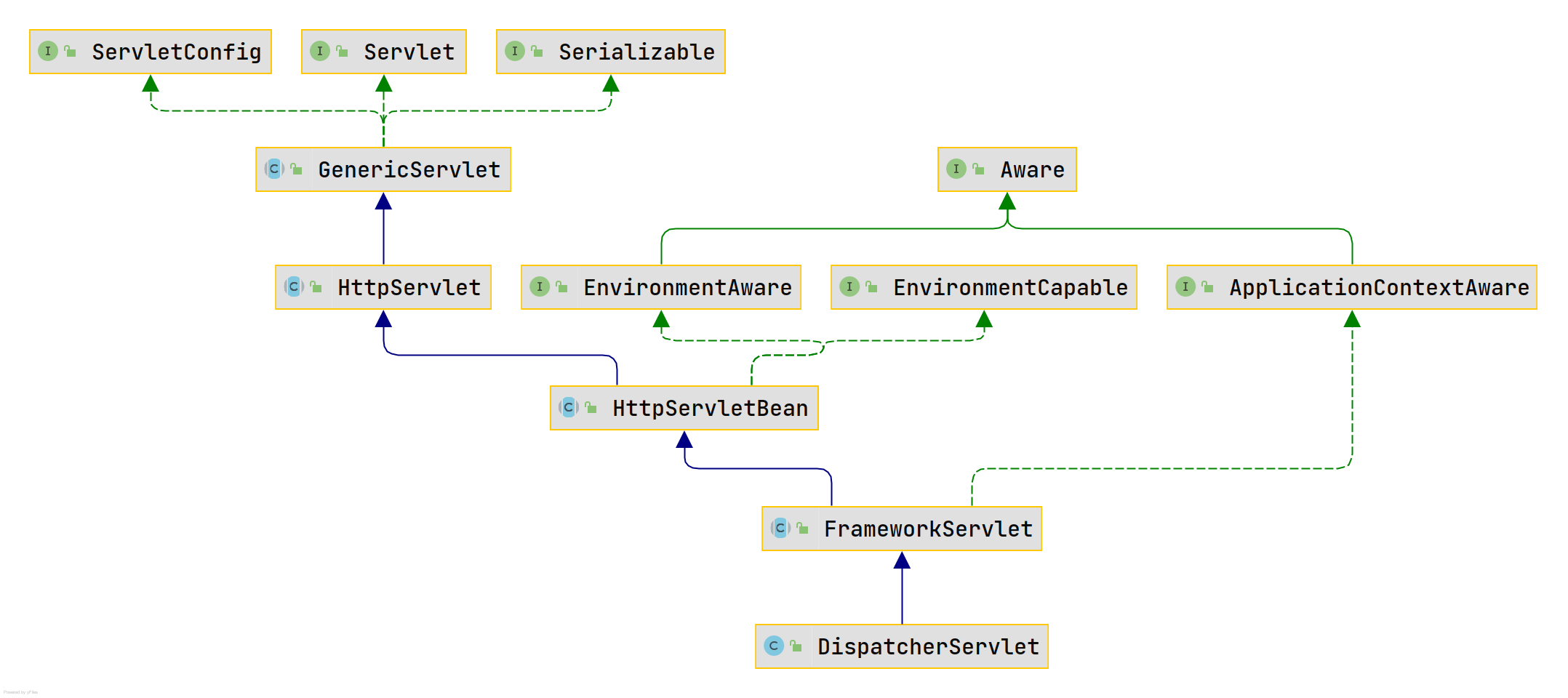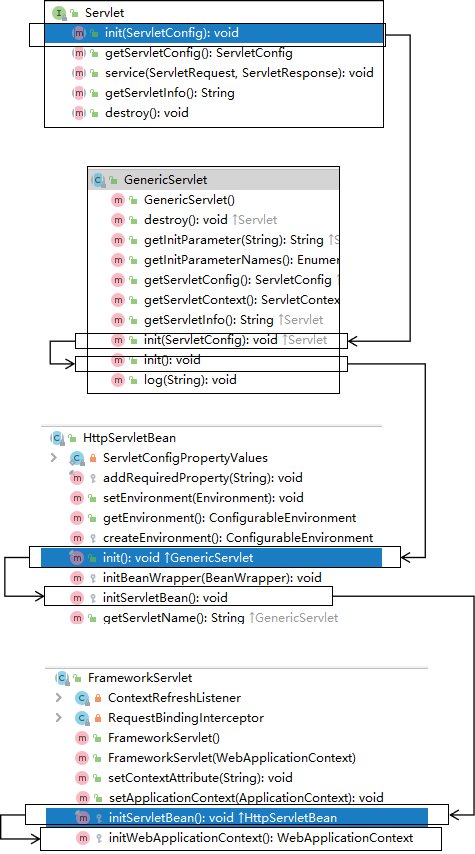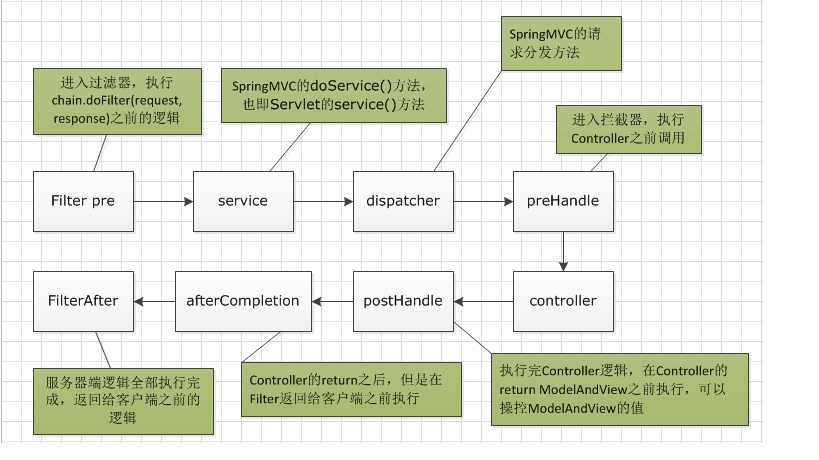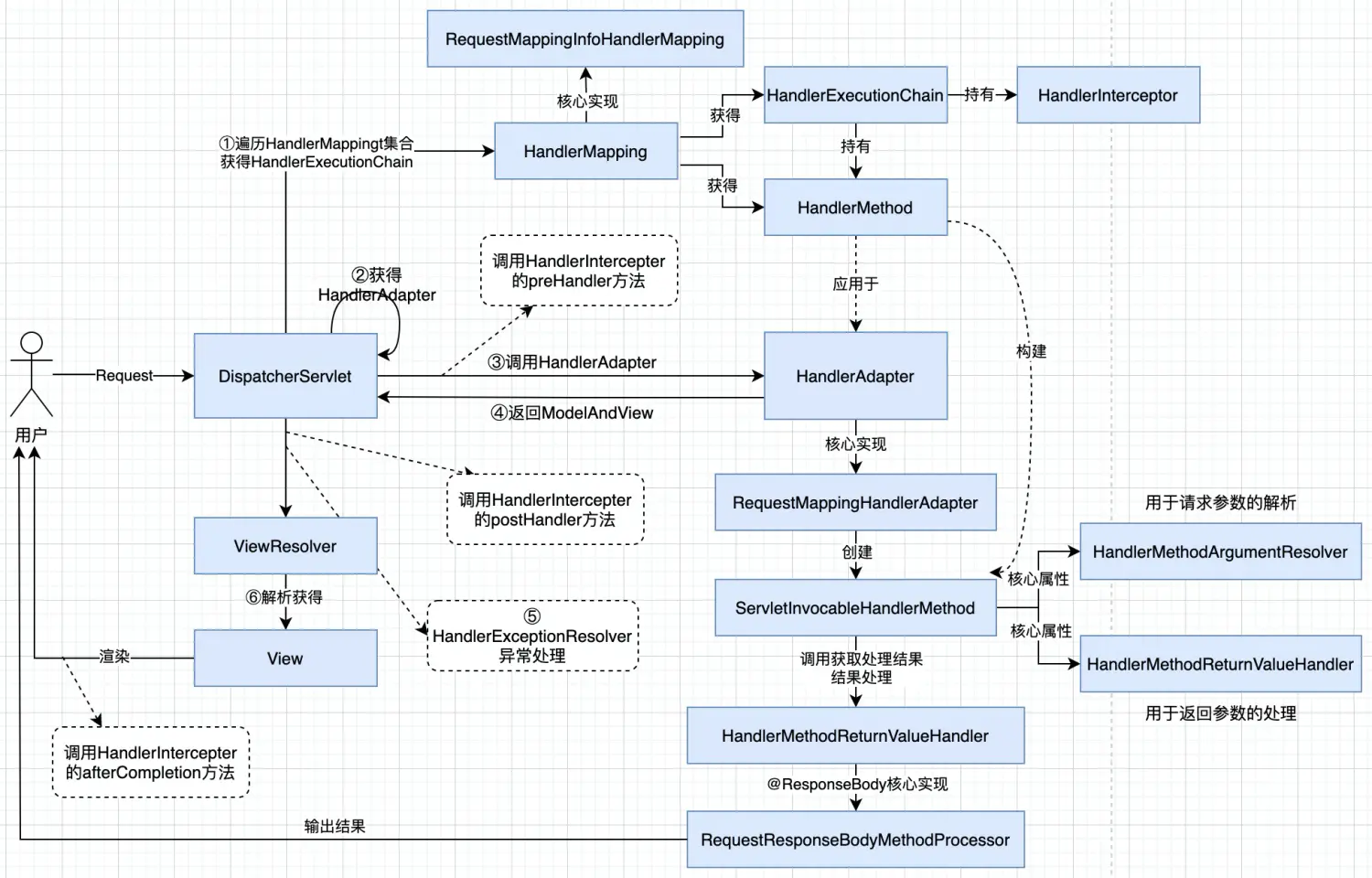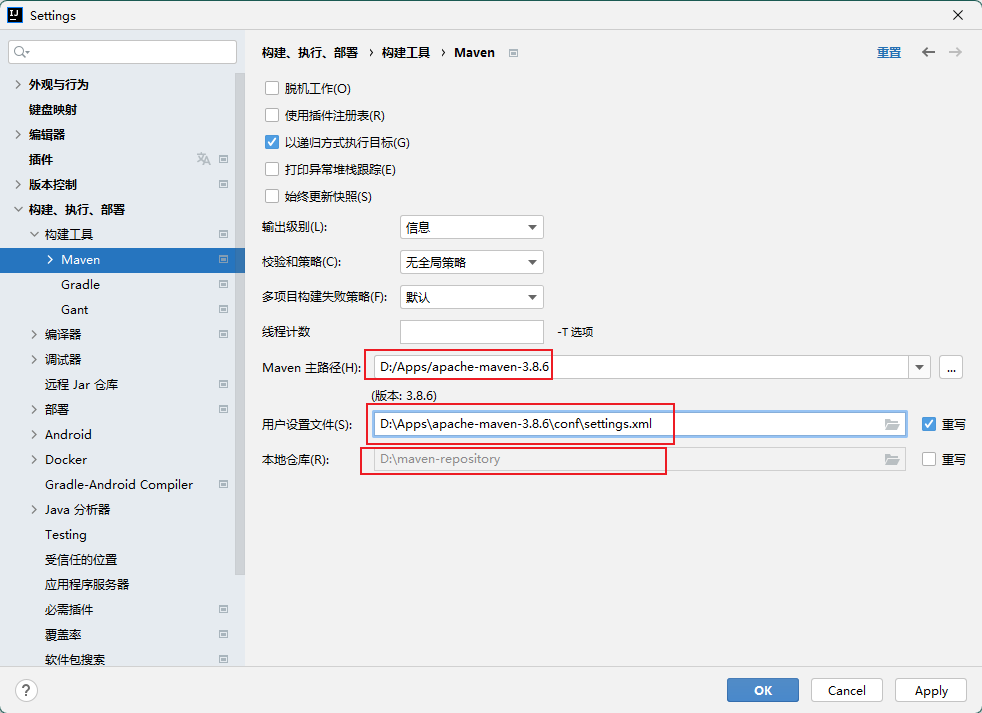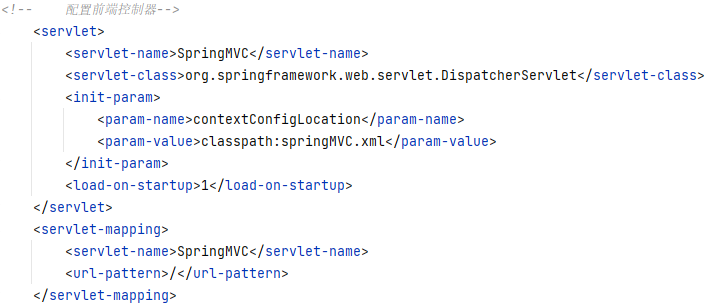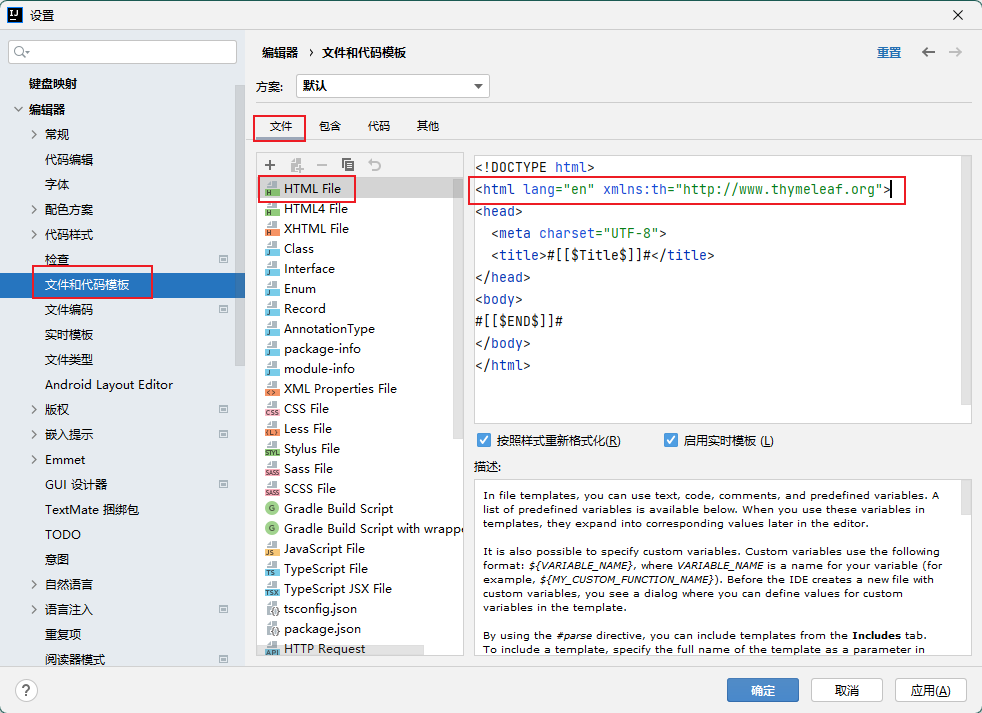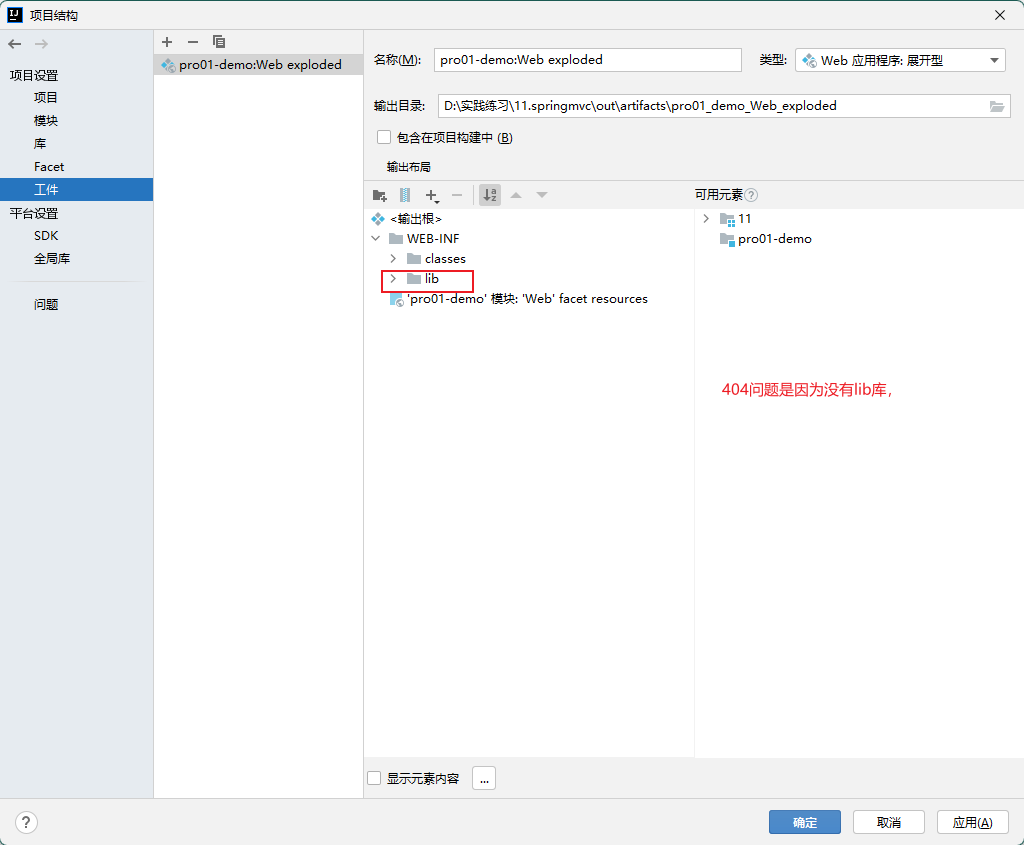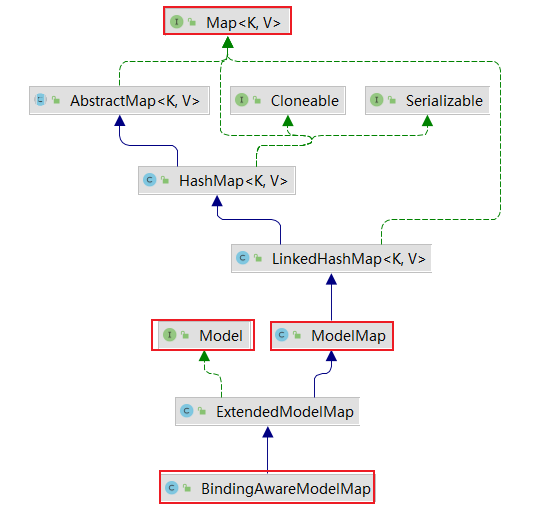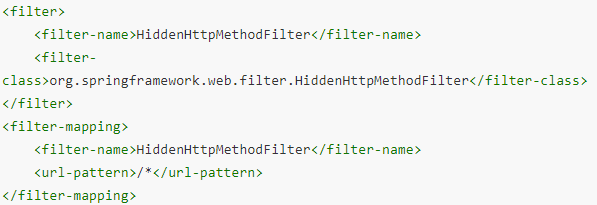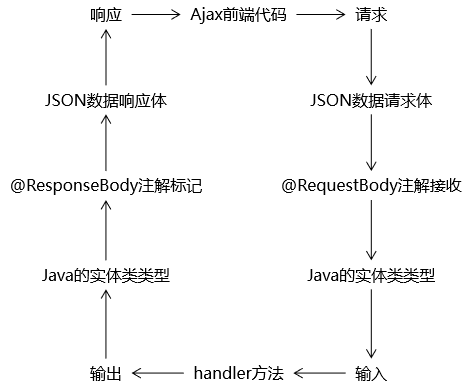通常我们认为,Spring MVC 是 Spring 的子项目,其实,它谈不上是一个独立的子项目,因为连一个正规的名字都没有。Spring Web MVC 是基于 Servlet API 构建的原始 Web 框架,从一开始就包含在 Spring 框架中。正式名称“Spring Web MVC”来自其源模块(spring-webmvc)的名称,但更常见的名称是“Spring MVC”。
MVC是一种软件架构的思想,将软件按照模型、视图、控制器来划分M:Model,模型层,指工程中的JavaBean,作用是处理数据
JavaBean分为两类:
一类称为实体类Bean:专门存储业务数据的,如 Student、User等
一类称为业务处理 Bean:指 Service或 Dao对象,专门用于处理业务逻辑和数据访问。
V:View,视图层,指工程中的 html 或 jsp 等页面,作用是与用户进行交互,展示数据C:Controller,控制层,指工程中的servlet,作用是接收请求和响应浏览器MVC的工作流程:用户通过视图层发送请求到服务器,在服务器中请求被Controller接收,Controller调用相应的 Model 层处理请求,处理完毕将结果返回到Controller,Controller再根据请求处理的结果找到相应的 View 视图,渲染数据后最终响应给浏览器
SpringMVC是Spring的一个后续产品,是 Spring 的一个子项目SpringMVC 是 Spring 为表述层开发提供的一整套完备的解决方案。在表述层框架历经 Strust、WebWork、Strust2 等诸多产品的历代更迭之后,目前业界普遍选择了 SpringMVC 作为 JavaEE 项目表述层开发的首选方案 。注:三层架构分为表述层(或表示层)、业务逻辑层、数据访问层,表述层表示前台页面和后台servlet
**Spring **家族原生产品 ,与IOC容器等基础设施无缝对接基于原生的 **Servlet**,通过了功能强大的前端控制器 **DispatcherServlet**,对请求和响应进行统一处理表述层各细分领域需要解决的问题全方位覆盖 ,提供全面解决方案
代码清新简洁 ,大幅度提升开发效率内部组件化程度高,可插拔式组件即插即用 ,想要什么功能配置相应组件即可
性能卓著 ,尤其适合现代大型、超大型互联网项目要求
IDEA2021.2.4
maven3.5.4【3.8.6 版本与 idea2021 使用会找不到依赖】
tomcat8
Spring5.3.1
创建项目:
修改本地 maven 仓库:
添加框架支持,因为为 web 项目。
这里使用框架支持还是手动建立 web 目录都没有区别,配置好工件路径即可。【参见 JavaWeb4.1】
必须的依赖:
Spring MVC日志:logback
servlet apithymeleaf
1 2 3 4 5 6 7 8 9 10 11 12 13 14 15 16 17 18 19 20 21 22 23 24 25 26 27 28 29 30 31 32 33 34 35 36 37 38 39 40 41 42 43 44 45 46 47 48 <?xml version="1.0" encoding="UTF-8" ?> <project xmlns ="http://maven.apache.org/POM/4.0.0" xmlns:xsi ="http://www.w3.org/2001/XMLSchema-instance" xsi:schemaLocation ="http://maven.apache.org/POM/4.0.0 http://maven.apache.org/xsd/maven-4.0.0.xsd" > <modelVersion > 4.0.0</modelVersion > <groupId > iceriver.springmvc</groupId > <artifactId > pro01-demo</artifactId > <version > 1.0-SNAPSHOT</version > <packaging > war</packaging > <dependencies > <dependency > <groupId > org.springframework</groupId > <artifactId > spring-webmvc</artifactId > <version > 5.3.1</version > </dependency > <dependency > <groupId > ch.qos.logback</groupId > <artifactId > logback-classic</artifactId > <version > 1.2.3</version > </dependency > <dependency > <groupId > javax.servlet</groupId > <artifactId > javax.servlet-api</artifactId > <version > 3.1.0</version > <scope > provided</scope > </dependency > <dependency > <groupId > org.thymeleaf</groupId > <artifactId > thymeleaf-spring5</artifactId > <version > 3.0.12.RELEASE</version > </dependency > <dependency > <groupId > org.springframework</groupId > <artifactId > spring-webmvc</artifactId > <version > 5.3.1</version > <scope > compile</scope > </dependency > </dependencies > </project >
web.xml
配置SpringMVC的前端控制器DispatcheServlet,对浏览器发送的请求进行统一处理。
配置名为SpringMVC的servlet
1 2 3 4 5 6 7 8 9 10 11 12 13 14 <?xml version="1.0" encoding="UTF-8" ?> <web-app xmlns ="http://xmlns.jcp.org/xml/ns/javaee" xmlns:xsi ="http://www.w3.org/2001/XMLSchema-instance" xsi:schemaLocation ="http://xmlns.jcp.org/xml/ns/javaee http://xmlns.jcp.org/xml/ns/javaee/web-app_4_0.xsd" version ="4.0" > <servlet > <servlet-name > springMVC</servlet-name > <servlet-class > org.springframework.web.servlet.DispatcherServlet</servlet-class > </servlet > <servlet-mapping > <servlet-name > springMVC</servlet-name > <url-pattern > /</url-pattern > </servlet-mapping > </web-app >
/所匹配的请求可以是/login或.html或.js或.css方式的请求路径,但是/不能匹配.jsp请求路径的请求/*会匹配包括.jsp的请求
优化:加载springMVC.xml配置文件,并通过设置<load-on-startup>改变优先级,让在启动服务器时完成初始化,提高第一次请求的响应速度。
web.xml中声明了控制路径/,还需要定义控制 servlet 程序,如HelloControler.java,对不同的请求进行不同的处理。通过@Controller注解的方式将该控制类交给IoC管理,声明为控制器文件。
1 2 3 4 5 6 7 8 9 10 11 package iceriver.springmvc.controller;import org.springframework.stereotype.Controller;@Controller public class HelloController {}
springMVC.xml配置文件
1.2.4 中步骤二加载了springMVC.xml配置文件,但此时还没有,springMVC.xml的作用是 spring 框架的一个配置文件。这里需要建在resourses文件夹下。
springMVC 的配置文件具有默认的位置和名称
默认的位置:WEB-INF
默认的名称:-servlet.xml
若要为 springMVC 的配置文件设置自定义的位置和名称,需要在 servlet 标签中添加init-param标签
1.2.5 中使用了注解,因此需要在springMVC.xml文件中进行相应的配置以保证生效。
引入名称空间、开启组件扫描【参见 Spring2.3.2 部分】
这里没设置扫面指定注解
配置thymeleaf视图解析器。
采用了IoC属性注入的级联赋值
这里视图前缀部分规定了前端页面文件要放在WEB-INF/templates目录下
WEB-INF目录下的文件不能被前端请求直接访问,也不能被重定向访问,只能通过请求转发访问。
1 2 3 4 5 6 7 8 9 10 11 12 13 14 15 16 17 18 19 20 21 22 23 24 25 26 27 28 29 <?xml version="1.0" encoding="UTF-8" ?> <beans xmlns ="http://www.springframework.org/schema/beans" xmlns:xsi ="http://www.w3.org/2001/XMLSchema-instance" xmlns:context ="http://www.springframework.org/schema/context" xsi:schemaLocation ="http://www.springframework.org/schema/beans http://www.springframework.org/schema/beans/spring-beans.xsd http://www.springframework.org/schema/context https://www.springframework.org/schema/context/spring-context.xsd" > <context:component-scan base-package ="iceriver.springmvc.controller" /> <bean id ="viewResolver" class ="org.thymeleaf.spring5.view.ThymeleafViewResolver" > <property name ="order" value ="1" /> <property name ="characterEncoding" value ="UTF-8" /> <property name ="templateEngine" > <bean class ="org.thymeleaf.spring5.SpringTemplateEngine" > <property name ="templateResolver" > <bean class ="org.thymeleaf.spring5.templateresolver.SpringResourceTemplateResolver" > <property name ="prefix" value ="/WEB-INF/templates/" /> <property name ="suffix" value =".html" /> <property name ="templateMode" value ="HTML5" /> <property name ="characterEncoding" value ="UTF-8" /> </bean > </property > </bean > </property > </bean > </beans >
WEB-INF/templates目录下新建index.html文件
IDEA 不配置情况下,新建的 html 文件不带<html lang="en" xmlns:th="http://www.thymeleaf.org">后面的 thymeleaf 命名空间。可以通过设置进行修改
配置 tomcat 服务器【参见 JavaWeb4.2】
关于 404 错误:
index.html下新建target.html,并在index.html添加访问链接:<a th:href="@{/target}">访问target</a>
1 2 3 4 5 6 7 8 9 10 11 12 13 <!DOCTYPE html > <html lang ="en" xmlns:th ="http://www.thymeleaf.org" > <head > <meta charset ="UTF-8" /> <title > Title</title > </head > <body > hello <a th:href ="@{/target}" > 访问target</a > <a th:href ="@{/testForward}" > testForward</a > <a th:href ="@{/testRedirect}" > testRedirect</a > </body > </html >
HelloController.java中按照index同样的方式配置targe.html的访问方法。
1 2 3 4 5 6 7 8 9 10 11 12 13 14 15 16 17 18 19 20 21 22 23 24 25 26 27 28 package iceriver.springmvc.controller;import org.springframework.stereotype.Controller;import org.springframework.ui.ModelMap;import org.springframework.web.bind.annotation.RequestMapping;@Controller public class HelloController { @RequestMapping("/") public String index () { return "index" ; } @RequestMapping("/target") public String toTarget () { return "target" ; } @RequestMapping("/testForward") public String testForward () { return "forward:/target" ; } @RequestMapping("/testRedirect") public String testRedirect () { return "redirect:/target" ; } }
浏览器发送请求,若请求地址符合前端控制器的url-pattern(web.xml),该请求就会被前端控制器DispatcherServlet处理。前端控制器会读取SpringMVC的核心配置文件(springmvc.xml),通过扫描组件找到控制器,将请求地址和控制器中@RequestMapping注解的value属性值进行匹配,若匹配成功,该注解所标识的控制器方法就是处理请求的方法。处理请求的方法需要返回一个字符串类型的视图名称,该视图名称会被视图解析器解析,加上前缀和后缀组成视图的路径,通过Thymeleaf对视图进行渲染,最终请求转发 到视图所对应页面。
@RequestMapping注解
作用:用于请求和处理请求的控制器方法建立映射关系。
一个请求只能映射到一个控制器方法。一个请求映射多个控制器方法会报错。
使用位置:可以用于类(控制器)前,也可以用在方法前:
用在类前:设置请求路径的初始信息
用在方法前:设置请求路径的具体信息
同时使用时,相当于请求路径进行了拼接,要符合类前设置的路径后,再去匹配方法前的路径。
value:配置请求地址
value设置多个值时,表示该请求映射能够匹配多个请求地址所对应的请求value属性必须设置不匹配时报 404 错误
1 2 3 4 <a th:href ="@{/testRequestMapping}" > 测试@RequestMapping的value属性-->/testRequestMapping</a> <a th:href ="@{/test}" > 测试@RequestMapping的value属性-->/test</a >
1 2 3 4 @RequestMapping(value = {"/testRequestMapping", "/test"}) public String testRequestMapping () { return "success" ; }
mthod:通过请求的请求方式(get 或 post)匹配请求映射
RequestMethod.XXX设置多个时,表示该请求映射能够匹配多种请求方式的请求
处理 get 请求的映射:@GetMapping
处理 post 请求的映射:@PostMapping
处理 put 请求的映射:@PutMapping
处理 delete 请求的映射:@DeleteMapping
请求地址满足请求映射的 value 属性,但不满足 method 属性,浏览器报错 405 错误
目前浏览器只支持 get 和 post,在 form 表单提交时,设置了其他请求方式的字符串(put 或 delete),则按照默认的请求方式 get 处理
要发送 put 和 delete 请求,需要通过 spring 提供的过滤器HiddenHttpMethodFilter,详见 RESTful。
1 2 3 4 <a th:href ="@{/test}" > 测试@RequestMapping的value属性-->/test</a > <form th:action ="@{/test}" method ="post" > <input type ="submit" /> </form >
1 2 3 4 5 6 7 @RequestMapping( value = {"/testRequestMapping", "/test"}, method = {RequestMethod.GET, RequestMethod.POST} ) public String testRequestMapping () { return "success" ; }
params:通过请求的请求参数匹配请求映射。
params可以通过四种表达式设置请求参数和请求映射的匹配关系
"param":要求请求映射所匹配的请求必须携带 param 请求参数"!param":要求请求映射所匹配的请求必须不能携带 param 请求参数"param=value":要求请求映射所匹配的请求必须携带 param 请求参数且param=value"param!=value":要求请求映射所匹配的请求必须携带 param 请求参数但是param!=value
若当前请求满足@RequestMapping 注解的 value 和 method 属性,但是不满足 params 属性,此时页面回报错 400
1 2 3 <a th:href ="@{/test(username='admin',password=123456)" > 测试@RequestMapping的params属性-->/test</a>
1 2 3 4 5 6 7 8 @RequestMapping( value = {"/testRequestMapping", "/test"} ,method = {RequestMethod.GET, RequestMethod.POST} ,params = {"username","password!=123456"} ) public String testRequestMapping () { return "success" ; }
headers:通过请求的请求头信息匹配请求映射
headers可以通过四种表达式设置请求头信息和请求映射的匹配关系
"header":要求请求映射所匹配的请求必须携带 header 请求头信息"!header":要求请求映射所匹配的请求必须不能携带 header 请求头信息"header=value":要求请求映射所匹配的请求必须携带 header 请求头信息且 header=value"header!=value":要求请求映射所匹配的请求必须携带 header 请求头信息且 header!=value
若当前请求满足@RequestMapping注解的 value 和 method 属性,但是不满足 headers 属性,此时页面显示 404 错误,即资源未找到
@RequestMapping修饰的value属性代表的匹配路径可以使用 ant 风格,ant 风格的规则如下:
?:表示任意的单个字符
*:表示任意的 0 个或多个字符**:表示任意的一层或多层目录
使用**时只能连用,中间有任何其他字符会当作单个*
SpringMVC支持占位符,常用于RESTful风格中。占位符表示路径中该位置实际上是个参数。
1 <a th:href ="@{/testRest/1/admin}" > 测试路径中的占位符-->/testRest</a >
1 2 3 4 5 6 7 @RequestMapping("/testRest/{id}/{username}") public String testRest (@PathVariable("id") String id, @PathVariable("username") String username) { System.out.println("id:" +id+",username:" +username); return "success" ; }
使用HttpServletRequest对象的表单数据获取方法【参见 Javaweb5.7.5】
1 2 3 4 5 6 7 @RequestMapping("/testParam") public String testParam (HttpServletRequest request) { String username = request.getParameter("username" ); String password = request.getParameter("password" ); System.out.println("username:" +username+",password:" +password); return "success" ; }
1 2 3 4 5 @RequestMapping("/testParam") public String testParam (String username, String password) { System.out.println("username:" +username+",password:" +password); return "success" ; }
1 2 3 <a th:href ="@{/testParam(username='admin',password=123456)}" > 测试获取请求参数-->/testParam</a>
多个同名参数(如复选框),可以使用字符串接收,此时多个参数值会以,分隔。如hobby:a,b,c
多个同名参数(如复选框),也可以使用字符串数组接收,此时多个参数值会组成数组。
支持get、post、超链接传参。
通过控制方法形参获取请求参数的方式要求形参和实参的名称一模一样。
@RequestParam
通过控制方法形参获取请求参数的方式要求形参和实参的名称一模一样。对于名称不一样的情况,可以使用@RequestParam建立参数映射关系。
@RequestParam的属性:
value、name:二者等价,为形参和实参建立映射关系defaultValue:为实参设置默认值,如果user_name没有传递或传递"",则使用默认值。
不设置defaultValue,请求未传递参数时值为null
required:该参数是否必须,默认为 true,表示必须。
设置为 true 时,同时没有设置defaultValue,请求未传递参数时报40错误——请求未传参。
设置为 false,同时没有设置defaultValue,请求未传递参数时值为null。
@PathVariable:spring 提供的,获取路径中的参数,配合 restful 风格使用,转换成实体类的属性。
@RequestBody:spring 提供的,将前台提交的 json 数据转换为实体类对象
只能接收 post 请求,且提交数据为 json 格式
如果提交参数为路径拼接,使用了@RequestBody 获取参数会报 400
@param:mybatis 提供的,用于 Dao 层,确定 sql 语句的参数。
@PathVariable路径占位符
将请求头信息和控制器方法的形参创建映射关系。
属性有三个value、required、defaultValue
用法同@RequestParam
@CookieValue
将 cookie 数据和控制器方法的形参创建映射关系
属性有三个value、required、defaultValue,
用法同@RequestParam
参数类型使用 Cookie 时,可以得到整个 cookie 对象
可以在控制器方法形参位置传入一个pojo类对象作为形参,当请求的参数名和pojo的属性名一致,会自动赋值,即创建对象。
1 2 3 4 5 6 @RequestMapping("/testpojo") public String testPOJO (User user) { System.out.println(user); return "success" ; }
1 2 3 4 5 6 7 8 9 10 11 12 13 14 15 <form th:action ="@{/testpojo}" method ="post" > 用户名:<input type ="text" name ="username" /> 密码:<input type ="password" name ="password" /> 性别:<input type ="radio" name ="sex" value ="男" /> 男<input type ="radio" name ="sex" value ="女" /> 女 年龄:<input type ="text" name ="age" /> 邮箱:<input type ="text" name ="email" /> <input type ="submit" /> </form >
GET请求乱码:跟 tomcat 版本有关,【参见 JavaWeb5.7.5】POST请求乱码:在web.xml文件中,使用过滤器
1 2 3 4 5 6 7 8 9 10 11 12 13 14 15 16 17 <filter > <filter-name > CharacterEncodingFilter</filter-name > <filter-class > org.springframework.web.filter.CharacterEncodingFilter</filter-class > <init-param > <param-name > encoding</param-name > <param-value > UTF-8</param-value > </init-param > <init-param > <param-name > forceResponseEncoding</param-name > <param-value > true</param-value > </init-param > </filter > <filter-mapping > <filter-name > CharacterEncodingFilter</filter-name > <url-pattern > /*</url-pattern > </filter-mapping >
request域对象共享数据request域对象共享数据的原理
SpringMVC 本质上是请求转发,这样从头到尾是一个请求,所以可以通过request域对象共享数据。
request域对象共享数据的方式
使用ServletAPI向request域对象共享数据:
1 2 3 4 5 @RequestMapping("/testServletAPI") public String testServletAPI (HttpServletRequest request) { request.setAttribute("testScope" , "hello,servletAPI" ); return "success" ; }
使用ModelAndView向request域对象共享数据:
1 2 3 4 5 6 7 @RequestMapping("/testModelAndView") public ModelAndView testModelAndView () { ModelAndView mav = new ModelAndView (); mav.addObject("testScope" , "hello,ModelAndView" ); mav.setViewName("success" ); return mav; }
使用 Model 向 request 域对象共享数据
1 2 3 4 5 @RequestMapping("/testModel") public String testModel (Model model) { model.addAttribute("testScope" , "hello,Model" ); return "success" ; }
使用 map 向 request 域对象共享数据
1 2 3 4 5 @RequestMapping("/testMap") public String testMap (Map<String, Object> map) { map.put("testScope" , "hello,Map" ); return "success" ; }
使用 ModelMap 向 request 域对象共享数据
1 2 3 4 5 @RequestMapping("/testModelMap") public String testModelMap (ModelMap modelMap) { modelMap.addAttribute("testScope" , "hello,ModelMap" ); return "success" ; }
五种方式对比:
类
参数类型
方法
返回值
HttpServletRequestHttpServletRequestsetAttribute()字符串页面名
ModelAndView无参
addObject()ModelAndView的的对象
ModelModeladdAttribute()字符串页面名
Map<String, Object>Map<String, Object>
put()字符串页面名
ModelMapModelMapaddAttribute()字符串页面名
HttpServletRequest是servlet的原生对象。Model、ModelMap、Map本质运行类型均为BindingAwareModelMap【使用了多态】,本质一样。Model 转发时将数据放入到请求域中,重定向则是放到路径参数上。????是这样吗,
request域对象属性
request域对象设置的属性,thymeleaf调用时可以直接使用属性名调用。
session域对象共享数据
使用原生的HttpSession类对象进行设置,方法为setAttribute()
使用属性时,需要使用session.属性名
1 2 3 4 5 @RequestMapping("/testSession") public String testSession (HttpSession session) { session.setAttribute("testSessionScope" , "hello,session" ); return "success" ; }
application域对象共享数据application域对象
application域对象是ServletContext的实例对象获取ServletContext实例对象的方式有多种:【参见 Javaweb5.7.3】
通过request对象获取:request.getServletContext()
通过session对象获取:session.getServletContext()
通过init()方法中,通过ServletConfig对象获取:servletConfig.getServletContext()。
通过 jsp 页面的pageContext内置对象
1 2 3 4 5 6 @RequestMapping("/testApplication") public String testApplication (HttpSession session) { ServletContext application = session.getServletContext(); application.setAttribute("testApplicationScope" , "hello,application" ); return "success" ; }
设置即原生方式:调用ServletContext类对象的setAttribute()方法进行设置
使用即原生方式:通过application.属性名
addAttribute():添加数据会添加到重定向的路径上,作为请求参数,使用@requestparam 注解获取。
addFlashAttribute():将数据放到 session 里面,但是只能读取一次。
SpringMVC 中的视图是 View 接口,视图的作用渲染数据,将模型 Model 中的数据展示给用户
SpringMVC 视图的种类很多,默认有转发视图和重定向视图
如果 springmvc 配置文件没有配置视图解析器,应该样实现请求访问呢?
2022.07.20 测试:
配置了InternalResourceView视图解析(未配置前后缀)、不配置视图解析器,使用 forward、不使用 forward,只要控制器地址写从 web 路径开始的文件全路径,就可以访问到 jsp 页面。
但不能访问 html 页面、配置了前后缀会访问不到 jsp 页面。
SpringMVC 中默认的转发视图是InternalResourceView
当控制器方法中所设置的视图名称以forward:为前缀时,此时的视图名称不会被 SpringMVC 配置文件中所配置的视图解析器解析,而是会将前缀forward:去掉,剩余部分作为最终路径通过转发的方式实现跳转
没有写forward:,且没有配置视图解析器时,默认的转发视图也是InternalResourceView
不能直接跳转WEB-INF下的静态资源,必须跳转到控制器中的其他跳转方法。
SpringMVC 中默认的重定向视图是RedirectView
当控制器方法中所设置的视图名称以redirect:为前缀时,此时的视图名称不会被 SpringMVC 配置文件中所配置的视图解析器解析,而是会将前缀redirect:去掉,剩余部分作为最终路径通过重定向的方式实现跳转
不能直接跳转WEB-INF下的静态资源,必须跳转到控制器中的其他跳转方法。
重定向视图和转发视图都会让浏览器地址发生变化,但转发视图最后的地址为请求的地址(forward后的部分),重定向视图最后的地址为转发后处理的地址(redirect给了谁,这个谁处理后的地址才是浏览器的地址)
从前端请求的角度看,重定向的地址跳到了不是他发起请求的一个地址。
当控制器方法中所设置的视图名称没有任何前缀时,此时的视图名称会被 SpringMVC 配置文件中所配置的视图解析器解析,视图名称拼接视图前缀和视图后缀所得到的最终路径,会通过转发的方式实现跳转
InternalResourceView
SpringMVC 默认的视图解析器,不配置视图解析器,或者配置了视图解析器,但转发以forward:开头,或者配置的视图解析器就是InternalResourceView(如 jsp 页面),则使用该视图的方式(前后缀)进行跳转。
当控制器方法中,仅仅用来实现页面跳转,没有其他处理时,可以在SpringMVC.xml 配置文件中将处理器方法使用<view-controller>标签进行表示,在配置文件中完成跳转。
<mvc:view-controller path="/testView" view-name="success"></mvc:view-controller>
path:设置处理的请求地址view-name:设置请求地址所对应的视图名称
1 2 <mvc:view-controller path="/" view-name="index" /><!--配置视图控制器--><!--访问首页--> <mvc:annotation-driven /><!--开启mvc注解驱动-->
当 SpringMVC 配置文件中设置任何一个<view-controller>时,控制器中的其他请求映射方法将全部失效,此时需要在 SpringMVC 配置文件中开启 mvc 注解驱动:
<mvc:annotation-driven /><mvc:annotation-driven />功能有很多,这里只是用到了它的一个很小的点。
REST:Representational State Transfer,表现层资源状态转移。
资源是一种看待服务器的方式,即,将服务器看作是由很多离散的资源组成。每个资源是服务器上一个可命名的抽象概念。因为资源是一个抽象的概念,所以它不仅仅能代表服务器文件系统中的一个文件、数据库中的一张表等等具体的东西,可以将资源设计的要多抽象有多抽象,只要想象力允许而且客户端应用开发者能够理解。与面向对象设计类似,资源是以名词为核心来组织的,首先关注的是名词。一个资源可以由一个或多个 URI 来标识。URI 既是资源的名称,也是资源在 Web 上的地址。对某个资源感兴趣的客户端应用,可以通过资源的 URI 与其进行交互。
资源的表述是一段对于资源在某个特定时刻的状态的描述。可以在客户端-服务器端之间转移(交换)。资源的表述可以有多种格式,例如 HTML/XML/JSON/纯文本/图片/视频/音频等等。资源的表述格式可以通过协商机制来确定。请求-响应方向的表述通常使用不同的格式。
状态转移说的是:在客户端和服务器端之间转移(transfer)代表资源状态的表述。通过转移和操作资源的表述,来间接实现操作资源的目的。
RESTful 中,将 HTTP 协议里面,四个表示操作方式:GET、POST、PUT、DELETE对应成四种基本操作:
GET 用来获取资源POST 用来新建资源PUT 用来更新资源DELETE 用来删除资源。
REST 风格提倡 URL 地址使用统一的风格设计,从前到后各个单词使用斜杠分开,不使用问号键值对方式携带请求参数,而是将要发送给服务器的数据作为 URL 地址的一部分,以保证整体风格的一致性。
操作 传统方式 REST 风格
查询操作
getUserById?id=1
user/1–>get 请求方式
保存操作
saveUser
user–>post 请求方式
删除操作
deleteUser?id=1
user/1–>delete 请求方式
更新操作
updateUser
user–>put 请求方式
浏览器只支持发送get和post方式的请求,SpringMVC 提供了HiddenHttpMethodFilter 帮助我们将 POST 请求转换为 DELETE 或 PUT 请求。
HiddenHttpMethodFilter 处理put和delete请求的条件:
当前请求的请求方式必须为post。
当前请求必须传输请求参数_method。
请求参数_method的值才是最终的请求方式。
put和delete请求的实现步骤:
在web.xml中注册HiddenHttpMethodFilter。
注意点:在web.xml中注册时,必须先注册CharacterEncodingFilter,再注册HiddenHttpMethodFilter,因为CharacterEncodingFilter内部有一个获取请求方式的操作,如果不提前设置好编码,会出现乱码情况:
String paramValue = request.getParameter(this.methodParam);
功能 URL 地址 请求方式
访问首页
/
GET
查询全部数据
/employee
GET
删除
/employee/2
DELETE
跳转到添加数据页面
/toAdd
GET
执行保存
/employee
POST
跳转到更新数据页面
/employee/2
GET
执行更新
/employee
PUT
1 <a th:href ="@{/employee}" > 访问员工信息</a >
1 2 3 4 5 6 @RequestMapping(value = "/employee", method = RequestMethod.GET) public String getEmployeeList (Model model) { Collection<Employee> employeeList = employeeDao.getAll(); model.addAttribute("employeeList" , employeeList); return "employee_list" ; }
1 2 3 4 5 6 7 8 9 10 11 12 13 14 15 16 17 18 19 20 21 22 23 24 25 26 27 28 29 30 31 32 33 <table border ="1" cellpadding ="0" cellspacing ="0" style ="text-align: center;" id ="dataTable" > <tr > <th colspan ="5" > Employee Info</th > </tr > <tr > <th > id</th > <th > lastName</th > <th > email</th > <th > gender</th > <th > options(<a th:href ="@{/toAdd}" > add</a > )</th > </tr > <tr th:each ="employee : ${employeeList}" > <td th:text ="${employee.id}" > </td > <td th:text ="${employee.lastName}" > </td > <td th:text ="${employee.email}" > </td > <td th:text ="${employee.gender}" > </td > <td > <a class ="deleteA" @click ="deleteEmployee" th:href ="@{'/employee/'+${employee.id}}" > delete</a > <a th:href ="@{'/employee/'+${employee.id}}" > update</a > </td > </tr > </table >
1 2 3 4 5 6 7 8 9 10 11 12 13 14 15 16 17 18 19 20 21 22 23 24 25 26 27 28 29 30 <a class ="deleteA" @click ="deleteEmployee" th:href ="@{'/employee/'+${employee.id}}" > delete</a> <form id ="delete_form" method ="post" > <input type ="hidden" name ="_method" value ="delete" /> </form > <script type ="text/javascript" > var vue = new Vue ({ el : "#dataTable" , methods : { deleteEmployee : function (event ) { var delete_form = document .getElementById ("delete_form" ); delete_form.action = event.target .href ; delete_form.submit (); event.preventDefault (); }, }, }); </script >
这里用到了vue.js,由于vue.js不经过中央控制器处理,所以需要开启静态资源(本地 js、css、img)加载:
springMVC的前端控制器不能处理静态资源Servlet的默认前端控制器defaultServlet可以处理静态资源,这个defaultServlet定义在 tomcat 的web.xml——全局配置在本地配置——项目的web.xml中使用<mvc:default-servlet-handler/>进行开启
静态资源处理顺序:springmvc→defaultservlet→404
1 2 3 4 5 @RequestMapping(value = "/employee/{id}", method = RequestMethod.DELETE) public String deleteEmployee (@PathVariable("id") Integer id) { employeeDao.delete(id); return "redirect:/employee" ; }
1 2 <a th:href ="@{/toAdd}" > add</a>
1 <mvc:view-controller path ="/toAdd" view-name ="employee_add" />
1 2 3 4 5 6 7 <form th:action ="@{/employee}" method ="post" > lastName:<input type ="text" name ="lastName" /> <br /> email:<input type ="text" name ="email" /> <br /> gender:<input type ="radio" name ="gender" value ="1" /> male <input type ="radio" name ="gender" value ="0" /> female<br /> <input type ="submit" value ="add" /> <br /> </form >
1 2 3 4 5 @RequestMapping(value = "/employee", method = RequestMethod.POST) public String addEmployee (Employee employee) { employeeDao.save(employee); return "redirect:/employee" ; }
1 <a th:href ="@{'/employee/' + ${employee.id}}" > update</a >
1 2 3 4 5 6 @RequestMapping(value = "/employee/{id}", method = RequestMethod.GET) public String getEmployeeById (@PathVariable("id") Integer id, Model model) { Employee employee = employeeDao.get(id); model.addAttribute("employee" , employee); return "employee_update" ; }
1 2 3 4 5 6 7 8 9 10 11 12 13 14 15 16 17 18 19 20 21 22 23 24 25 26 27 28 29 <form th:action ="@{/employee}" method ="post" > <input type ="hidden" name ="_method" value ="put" /> <input type ="hidden" name ="id" th:value ="${employee.id}" /> <label for ="" > lastName:<input type ="text" name ="lastName" th:value ="${employee.lastName}" /> </label > <label for ="" > email:<input type ="text" name ="email" th:value ="${employee.email}" /> </label > <label for ="" > gender:<input type ="radio" name ="gender" value ="1" th:field ="${employee.gender}" /> male <input type ="radio" name ="gender" value ="0" th:field ="${employee.gender}" /> female </label > <input type ="submit" value ="修改" /> </form >
1 2 3 4 5 @RequestMapping(value = "/employee", method = RequestMethod.PUT) public String updateEmployee (Employee employee) { employeeDao.save(employee); return "redirect:/employee" ; }
HttpMessageConverter,报文信息转换器,将请求报文转换为 Java 对象,或将 Java 对象转换为响应报文HttpMessageConverter提供了两个注解和两个类型:
@RequestBody,@ResponseBody,RequestEntity,ResponseEntity
@RequestBody
标识控制器形参。
@RequestBody可以获取请求体,需要在控制器方法设置一个形参,使用@RequestBody进行标识,当前请求的请求体就会为当前注解所标识的形参赋值。前端发送的数据格式需为 json 格式字符串。json 格式对象会报错,需要使用@@RequestParam
1 2 3 4 5 <form th:action ="@{/testRequestBody}" method ="post" > 用户名:<input type ="text" name ="username" /> <br /> 密码:<input type ="password" name ="password" /> <br /> <input type ="submit" /> </form >
1 2 3 4 5 @RequestMapping("/testRequestBody") public String testRequestBody (@RequestBody String requestBody) { System.out.println("requestBody:" +requestBody); return "success" ; }
RequestEntity
标识控制器形参类型。
RequestEntity封装请求报文的一种类型,需要在控制器方法的形参中设置该类型的形参,当前请求的请求报文就会赋值给该形参,可以通过getHeaders()获取请求头信息,通过getBody()获取请求体信息
1 2 3 4 5 <form th:action ="@{/testRequestEntity}" method ="post" > <input type ="text" name ="username" /> <input type ="text" name ="password" /> <input type ="submit" value ="测试RequestEntity" /> </form >
1 2 3 4 5 6 @RequestMapping("/testRequestEntity") public String testRequestEntity (RequestEntity<String> requestEntity) { System.out.println("requestHeader:" +requestEntity.getHeaders()); System.out.println("requestBody:" +requestEntity.getBody()); return "success" ; }
@ResponseBodyservletAPI的HttpServletResponse响应数据1 <a th:href ="@{/testResponse}" > 通过servletAPI的response对象响应浏览器数据</a >
1 2 3 4 @RequestMapping("/testResponse") public void testResponse (HttpServletResponse response) throws IOException { response.getWriter().print("hello,response" ); }
@ResponseBody返回文本信息1 <a th:href ="@{/testResponse}" > 通过servletAPI的response对象响应浏览器数据</a >
1 2 3 4 5 @RequestMapping(value = "/testResponseBody", produces = "text/html;charset=UTF-8") @ResponseBody public String testResponseBody () { return "成功" ; }
@ResponseBody返回实体对象(springmvc 处理 json)
浏览器无法直接解析 java 语言的实体对象,可以通过转换为 json 格式的字符串进行输出。
1 2 3 4 5 <dependency > <groupId > com.fasterxml.jackson.core</groupId > <artifactId > jackson-databind</artifactId > <version > 2.12.1</version > </dependency >
1 <a th:href ="@{/testResponseUser}" > 通过@ResponseBody响应浏览器User对象</a >
1 2 3 4 5 @RequestMapping(value = "/testResponseUser", produces = "text/html;charset=UTF-8") @ResponseBody public User testResponseUser () { return new User (1001 , "admin" , "123456" , 23 , "男" ); }
springmvc处理json的必要条件:
pom.xml添加了依赖srpingMVC.xml开启了注解驱动
<mvc:annotation-driven />
处理器方法使用@ResponseBody注解
处理器方法返回值类型为实体类,返回值为实体类对象
@ResponseBody与 springmvc 处理 ajax1 2 3 4 5 6 7 8 9 10 11 12 13 14 15 16 17 18 19 20 21 22 23 24 25 <div id ="app" > <a @click ="testAxios" th:href ="@{/testAxios}" > SpringMVC处理ajax</a > </div > <script type ="text/javascript" th:src ="@{/static/js/vue.js}" > </script > <script type ="text/javascript" th:src ="@{/static/js/axios.min.js}" > </script > <script type ="text/javascript" > new Vue ({ el : "#app" , methods : { testAxios : function (event ) { axios ({ method : "post" , url : event.target .href , params : { username : "admin" , password : "123456" , }, }).then (function (response ) { alert (response.data ); }); event.preventDefault (); }, }, }); </script >
1 2 3 4 5 6 @RequestMapping("/testAxios") @ResponseBody public String testAxios (String username, String password) { System.out.println(username+"," +password); return "hello,axios" ; }
ResponseEntity
标识控制器方法的返回值类型。
ResponseEntity用于控制器方法的返回值类型,该控制器方法的返回值就是响应到浏览器的响应报文
1 <a th:href ="@{testDown}" > 下载1.jpg</a >
1 2 3 4 5 6 7 8 9 10 11 12 13 14 15 16 17 18 19 20 21 22 23 24 25 26 27 28 29 30 31 32 33 34 35 36 37 38 39 40 41 42 43 44 45 46 package iceriver.springmvc.controller;import org.springframework.http.HttpHeaders;import org.springframework.http.HttpStatus;import org.springframework.http.ResponseEntity;import org.springframework.stereotype.Controller;import org.springframework.util.MultiValueMap;import org.springframework.web.bind.annotation.RequestMapping;import javax.servlet.ServletContext;import javax.servlet.http.HttpSession;import java.io.FileInputStream;import java.io.IOException;import java.io.InputStream;@Controller public class FileUpAndFileDownload { @RequestMapping("/testDown") public ResponseEntity<byte []> testResponseEntity(HttpSession session) throws IOException { ServletContext servletContext = session.getServletContext(); String realPath = servletContext.getRealPath("/static/img/1.jpg" ); InputStream is = new FileInputStream (realPath); byte [] bytes = new byte [is.available()]; is.read(bytes); MultiValueMap<String, String> headers = new HttpHeaders (); headers.add("Content-Disposition" , "attachment;filename=1.jpg" ); HttpStatus statusCode = HttpStatus.OK; ResponseEntity<byte []> responseEntity = new ResponseEntity <>(bytes, headers, statusCode); is.close(); return responseEntity; } }
pom.xml文件中,添加依赖:
1 2 3 4 5 6 <dependency > <groupId > commons-fileupload</groupId > <artifactId > commons-fileupload</artifactId > <version > 1.3.1</version > </dependency >
springMVC.xml文件中添加配置——文件上传解析器:
1 2 <bean id ="multipartResolver" class ="org.springframework.web.multipart.commons.CommonsMultipartResolver" />
实现上传:
1 2 3 4 <form th:action ="@{/testUp}" method ="post" enctype ="multipart/form-data" > 头像:<input type ="file" name ="photo" /> <input type ="submit" value ="上传" /> </form >
1 2 3 4 5 6 7 8 9 10 11 12 13 14 15 16 17 18 @RequestMapping("/testUp") public String testUp (MultipartFile photo, HttpSession session) throws IOException { String fileName = photo.getOriginalFilename(); ServletContext servletContext = session.getServletContext(); String photoPath = servletContext.getRealPath("photo" ); File file = new File (photoPath); if (!file.exists()){ file.mkdir(); } String finalPath = photoPath + File.separator + fileName; photo.transferTo(new File (finalPath)); return "success" ; }
解决同名文件上传后“文件内容”发生覆盖的情况:
1 2 3 4 5 6 7 8 9 10 11 12 13 14 15 16 17 18 19 20 21 22 23 24 @RequestMapping("/testUp") public String testUp (MultipartFile photo, HttpSession session) throws IOException { String fileName = photo.getOriginalFilename(); String suffixName = fileName.substring(fileName.lastIndexOf("." )); String uuid = UUID.randomUUID().toString().replaceAll("-" ,"" ); fileName = uuid + suffixName; ServletContext servletContext = session.getServletContext(); String photoPath = servletContext.getRealPath("photo" ); File file = new File (photoPath); if (!file.exists()){ file.mkdir(); } String finalPath = photoPath + File.separator + fileName; photo.transferTo(new File (finalPath)); return "success" ; }
@RestController注解
@RestController注解是springMVC提供的一个复合注解,标识在控制器的类 上,就相当于为类添加了@Controller注解,并且为其中的每个方法添加了@ResponseBody注解。
过滤器作用于请求发送到 dispatcherservlet 之前
拦截器作用于请求由 dispatcherservlet 发送到其他 controllersevlet
拦截器共有 3 个抽象方法【默认方法】:
preHandle():控制器方法执行之前执行,其boolean类型的返回值表示是否拦截或放行,返回true为放行,即调用控制器方法;返回false表示拦截,即不调用控制器方法postHandle():控制器方法执行之后执行afterComplation():处理完视图和模型数据,渲染视图完毕之后执行
注册拦截器:在springMVC.xml中配置拦截器:
1 2 3 4 <mvc:interceptor > <bean class ="com.atguigu.interceptor.FirstInterceptor" > </bean > <ref bean ="firstInterceptor" > </ref > </mvc:interceptor >
- ~~方式二(外部bean方式):~~
1 2 3 4 <bean class ="com.atguigu.interceptor.FirstInterceptor" > </bean > <mvc:interceptor > <ref bean ="firstInterceptor" > </ref > </mvc:interceptor >
- ~~方式三(注解方式):该方式需要对拦截器类~~`~~FirstInterceptor.java~~`~~使用~~`~~@Component~~`~~注解,将拦截器交给spring作为bean管理~~
1 2 3 4 <mvc:interceptor > <ref bean ="firstInterceptor" > </ref > </mvc:interceptor >
1 2 3 4 5 6 7 8 9 10 11 12 13 14 <mvc:interceptors > <mvc:interceptor > <mvc:mapping path ="/**" /> <mvc:exclude-mapping path ="/testRequestEntity" /> <ref bean ="firstInterceptor" > </ref > <bean class ="com.atguigu.interceptor.FirstInterceptor" > </bean > </mvc:interceptor > <mvc:interceptors >
使用拦截器:编写Interceptor拦截器类,继承于HandlerInterceptor,使用ctr+o进行 preHandle()方法重写,令两个方法可以不用。
将拦截器交给 spring 管理:
方式一:使用@Component注解,将拦截器交给 spring 作为 spring 管理
方式二:在 springMVC.xml 中使用标签把拦截器交给 spring 管理
缺少设置白名单、设置管理配置类的内容,还可以再丰富
若每个拦截器的preHandle()都返回true
preHandle()会按照配置的顺序执行,而postHandle()和afterComplation()会按照配置的反序执行
若某个拦截器的preHandle()返回了false
preHandle()返回false和它之前的拦截器的preHandle()都会执行。postHandle()都不执行。返回false的拦截器之前的拦截器的afterComplation()会执行
SpringMVC提供了一个处理控制器方法执行过程中所出现的异常的接口:HandlerExceptionResolverHandlerExceptionResolver接口的实现类有:DefaultHandlerExceptionResolver和SimpleMappingExceptionResolverSpringMVC提供了自定义的异常处理器SimpleMappingExceptionResolver在springMVC.xml文件配置异常处理:
1 2 3 4 5 6 7 8 9 10 11 12 <bean class ="org.springframework.web.servlet.handler.SimpleMappingExceptionResolver" > <property name ="exceptionMappings" > <props > <prop key ="java.lang.ArithmeticException" > error</prop > </props > </property > <property name ="exceptionAttribute" value ="ex" > </property > </bean >
创建配置类,使用@ControllerAdive注解标记为异常处理类
1 2 3 4 5 6 7 8 9 @ControllerAdvice public class ExceptionController { @ExceptionHandler(ArithmeticException.class) public String handleArithmeticException (Exception ex, Model model) { model.addAttribute("ex" , ex); return "error" ; } }
web.xml
在Servlet3.0环境中,容器会在类路径中查找实现javax.servlet.ServletContainerInitializer接口的类,如果找到的话就用它来配置Servlet容器。
Spring提供了这个接口的实现,名为SpringServletContainerInitializer,这个类反过来又会查找实现WebApplicationInitializer的类并将配置的任务交给它们来完成。Spring3.2引入了一个便利的WebApplicationInitializer基础实现,名为AbstractAnnotationConfigDispatcherServletInitializer,当我们的类扩展了AbstractAnnotationConfigDispatcherServletInitializer并将其部署到Servlet3.0容器的时候,容器会自动发现它,并用它来配置Servlet上下文。
1 2 3 4 5 6 7 8 9 10 11 12 13 14 15 16 17 18 19 20 21 22 23 24 25 26 27 28 29 30 31 32 33 34 35 36 37 38 39 40 41 42 public class WebInit extends AbstractAnnotationConfigDispatcherServletInitializer { @Override protected Class<?>[] getRootConfigClasses() { return new Class []{SpringConfig.class}; } @Override protected Class<?>[] getServletConfigClasses() { return new Class []{SpringMVC.class}; } @Override protected String[] getServletMappings() { return new String []{"/" }; } @Override protected Filter[] getServletFilters() { CharacterEncodingFilter encodingFilter = new CharacterEncodingFilter (); encodingFilter.setEncoding("UTF-8" ); encodingFilter.setForceRequestEncoding(true ); HiddenHttpMethodFilter hiddenHttpMethodFilter = new HiddenHttpMethodFilter (); return new Filter []{encodingFilter, hiddenHttpMethodFilter}; } }
1 2 3 4 5 6 7 8 9 10 11 12 13 14 15 16 17 18 19 20 21 22 23 24 25 26 27 28 29 30 31 32 33 34 35 36 37 38 39 40 41 42 43 44 45 46 47 48 49 50 51 52 53 54 55 56 57 58 59 60 61 62 63 64 65 66 67 68 69 70 71 72 73 @Configuration @ComponentScan("com.atguigu.mvc.controller") @EnableWebMvc public class SpringMVC implements WebMvcConfigurer { @Override public void configureDefaultServletHandling (DefaultServletHandlerConfigurer configurer) { configurer.enable(); } @Bean public MultipartResolver multipartResolver () { return new CommonsMultipartResolver (); } @Override public void addInterceptors (InterceptorRegistry registry) { FirstInterceptor firstInterceptor = new FirstInterceptor (); registry.addInterceptor(firstInterceptor).addPathPatterns("/**" ); } @Override public void addViewControllers (ViewControllerRegistry registry) { registry.addViewController("/success" ).setViewName("success" ); } @Override public void configureHandlerExceptionResolvers (List<HandlerExceptionResolver> resolvers) { SimpleMappingExceptionResolver exceptionResolver = new SimpleMappingExceptionResolver (); Properties prop = new Properties (); prop.setProperty("java.lang.ArithmeticException" , "error" ); exceptionResolver.setExceptionMappings(prop); exceptionResolver.setExceptionAttribute("ex" ); resolvers.add(exceptionResolver); } @Bean public ITemplateResolver templateResolver () { WebApplicationContext webApplicationContext = ContextLoader.getCurrentWebApplicationContext(); ServletContextTemplateResolver templateResolver = new ServletContextTemplateResolver (webApplicationContext.getServletContext()); templateResolver.setPrefix("/WEB-INF/templates/" ); templateResolver.setSuffix(".html" ); templateResolver.setCharacterEncoding("UTF-8" ); templateResolver.setTemplateMode(TemplateMode.HTML); return templateResolver; } @Bean public SpringTemplateEngine templateEngine (ITemplateResolver templateResolver) { SpringTemplateEngine templateEngine = new SpringTemplateEngine (); templateEngine.setTemplateResolver(templateResolver); return templateEngine; } @Bean public ViewResolver viewResolver (SpringTemplateEngine templateEngine) { ThymeleafViewResolver viewResolver = new ThymeleafViewResolver (); viewResolver.setCharacterEncoding("UTF-8" ); viewResolver.setTemplateEngine(templateEngine); return viewResolver; } }
DispatcherServlet:前端控制器,不需要工程师开发,由框架提供
作用:统一处理请求和响应,整个流程控制的中心,由它调用其它组件处理用户的请求
HandlerMapping:处理器映射器,不需要工程师开发,由框架提供
作用:根据请求的url、method等信息查找Handler,即控制器方法
HandlerAdapter:处理器适配器,不需要工程师开发,由框架提供
作用:通过HandlerAdapter对处理器(控制器方法)进行执行
Handler:处理器,需要工程师开发【即Controller】
作用:在DispatcherServlet的控制下Handler对具体的用户请求进行处理
ViewResolver:视图解析器,不需要工程师开发,由框架提供
作用:进行视图解析,得到相应的视图,例如:ThymeleafView、InternalResourceView、RedirectView
View:视图
DispatcherServlet 本质上是一个 Servlet,所以天然的遵循 Servlet 的生命周期,宏观上是 Servlet生命周期来进行调度。即,创建 web 服务时,从 Servlet 类的 init()方法开始执行。Servlet类中init()执行到最后是在FrameworkServlet类中调用了initWebApplicationContext()方法,而在该方法中,调用了createWebApplicationContext()方法
createWebApplicationContext()方法使用反射创建了 IOC 容器。initWebApplicationContext()方法将 IOC 容器在应用域中共享。
同时,在FrameworkServlet类的初始化initWebApplicationContext()方法中,调用了onRefresh(wac)方法,此方法在DispatcherServlet中进行了重写,调用了initStrategies(context)方法,初始化策略,即初始化DispatcherServlet的各个组件:
1 2 3 4 5 6 7 8 9 10 11 protected void initStrategies (ApplicationContext context) { initMultipartResolver(context); initLocaleResolver(context); initThemeResolver(context); initHandlerMappings(context); initHandlerAdapters(context); initHandlerExceptionResolvers(context); initRequestToViewNameTranslator(context); initViewResolvers(context); initFlashMapManager(context); }
web 容器在处理前端请求时,请求由Servlet类中的service()方法从上到下处理,而Servlet中的service()被HttpServlet类重写了。
后FrameworkServlet重写了HttpServlet中的service()和doXxx()(doGet()等),这些方法中调用了FrameworkServlet类中的processRequest(request, response)。
processRequest(request, response)调用了FrameworkServlet中的doService(),而doService()在FrameworkServlet是一个抽象方法,在DispatcherServlet类中进行了重写。DispatcherServlet中的doService()调用了DispatcherServlet中的doDispatch(),即该方法处理了最后的请求。请求处理后的视图处理等后续处理交给processDispatchResult()完成。
1 2 3 4 5 6 7 8 9 10 11 12 13 14 15 16 17 18 19 20 21 22 23 24 25 26 27 28 29 30 31 32 33 34 35 36 37 38 39 40 41 42 43 44 45 46 47 48 49 50 51 52 53 54 55 56 57 58 59 60 61 62 63 64 65 66 67 68 69 70 71 72 73 74 75 76 77 78 79 80 81 82 83 84 85 86 87 88 89 90 91 92 93 protected void doDispatch (HttpServletRequest request, HttpServletResponse response) throws Exception { HttpServletRequest processedRequest = request; HandlerExecutionChain mappedHandler = null ; boolean multipartRequestParsed = false ; WebAsyncManager asyncManager = WebAsyncUtils.getAsyncManager(request); try { ModelAndView mv = null ; Exception dispatchException = null ; try { processedRequest = checkMultipart(request); multipartRequestParsed = (processedRequest != request); mappedHandler = getHandler(processedRequest); if (mappedHandler == null ) { noHandlerFound(processedRequest, response); return ; } HandlerAdapter ha = getHandlerAdapter(mappedHandler.getHandler()); String method = request.getMethod(); boolean isGet = "GET" .equals(method); if (isGet || "HEAD" .equals(method)) { long lastModified = ha.getLastModified(request, mappedHandler.getHandler()); if (new ServletWebRequest (request, response).checkNotModified(lastModified) && isGet) { return ; } } if (!mappedHandler.applyPreHandle(processedRequest, response)) { return ; } mv = ha.handle(processedRequest, response, mappedHandler.getHandler()); if (asyncManager.isConcurrentHandlingStarted()) { return ; } applyDefaultViewName(processedRequest, mv); mappedHandler.applyPostHandle(processedRequest, response, mv); } catch (Exception ex) { dispatchException = ex; } catch (Throwable err) { dispatchException = new NestedServletException ("Handler dispatch failed" , err); } processDispatchResult(processedRequest, response, mappedHandler, mv, dispatchException); } catch (Exception ex) { triggerAfterCompletion(processedRequest, response, mappedHandler, ex); } catch (Throwable err) { triggerAfterCompletion(processedRequest, response, mappedHandler, new NestedServletException ("Handler processing failed" , err)); } finally { if (asyncManager.isConcurrentHandlingStarted()) { if (mappedHandler != null ) { mappedHandler.applyAfterConcurrentHandlingStarted(processedRequest, response); } } else { if (multipartRequestParsed) { cleanupMultipart(processedRequest); } } } }
1 2 3 4 5 6 7 8 9 10 11 12 13 14 15 16 17 18 19 20 21 22 23 24 25 26 27 28 29 30 31 32 33 34 35 36 37 38 39 40 41 42 43 private void processDispatchResult (HttpServletRequest request, HttpServletResponse response, @Nullable HandlerExecutionChain mappedHandler, @Nullable ModelAndView mv, @Nullable Exception exception) throws Exception { boolean errorView = false ; if (exception != null ) { if (exception instanceof ModelAndViewDefiningException) { logger.debug("ModelAndViewDefiningException encountered" , exception); mv = ((ModelAndViewDefiningException) exception).getModelAndView(); } else { Object handler = (mappedHandler != null ? mappedHandler.getHandler() : null ); mv = processHandlerException(request, response, handler, exception); errorView = (mv != null ); } } if (mv != null && !mv.wasCleared()) { render(mv, request, response); if (errorView) { WebUtils.clearErrorRequestAttributes(request); } } else { if (logger.isTraceEnabled()) { logger.trace("No view rendering, null ModelAndView returned." ); } } if (WebAsyncUtils.getAsyncManager(request).isConcurrentHandlingStarted()) { return ; } if (mappedHandler != null ) { mappedHandler.triggerAfterCompletion(request, response, null ); } }
用户向服务器发送请求,经过过滤器后请求被SpringMVC的前端控制器 DispatcherServlet捕获。
DispatcherServlet对请求URL进行解析,得到请求资源标识符(URI),通过handlermapping判断请求URI对应的映射:
不存在
再判断是否配置了mvc:default-servlet-handler——默认的前端控制器,处理静态资源
如果没配置,则控制台报映射查找不到,客户端展示 404 错误
如果有配置,则访问目标资源(一般为静态资源,如:JS,CSS,HTML),找不到客户端也会展示 404 错误
存在:执行下面流程
根据该URI,调用HandlerMapping获得该Handler配置的所有相关的对象(包括Handler对象以及Handler对象对应的拦截器),最后以HandlerExecutionChain执行链对象的形式返回。
DispatcherServlet 根据获得的Handler,选择一个合适的HandlerAdapter。如果成功获得HandlerAdapter,此时将开始执行拦截器的preHandler(…)方法【正向】
提取Request中的模型数据,填充Handler(控制器方法)入参,开始执行Handler(Controller)方法,处理请求。在填充Handler的入参过程中,根据你的配置,Spring将帮你做一些额外的工作:
HttpMessageConveter: 将请求消息(如Json、xml等数据)转换成一个对象,将对象转换为指定的响应信息数据转换:对请求消息进行数据转换。如String转换成Integer、Double等
数据格式化:对请求消息进行数据格式化。 如将字符串转换成格式化数字或格式化日期等
数据验证: 验证数据的有效性(长度、格式等),验证结果存储到 BindingResult 或 Error 中
Handler执行完成后,向DispatcherServlet 返回一个ModelAndView对象。此时将开始执行拦截器的postHandle(...)方法【逆向】。
根据返回的ModelAndView(此时会判断是否存在异常:如果存在异常,则执行HandlerExceptionResolver进行异常处理)选择一个适合的ViewResolver进行视图解析,根据Model和View,来渲染视图。
渲染视图完毕执行拦截器的afterCompletion(…)方法【逆向】。
将渲染结果返回给客户端。
原文链接: https://sk370.github.io/2022/07/19/springmvc/SpringMVC/
版权声明: 转载请注明出处。

